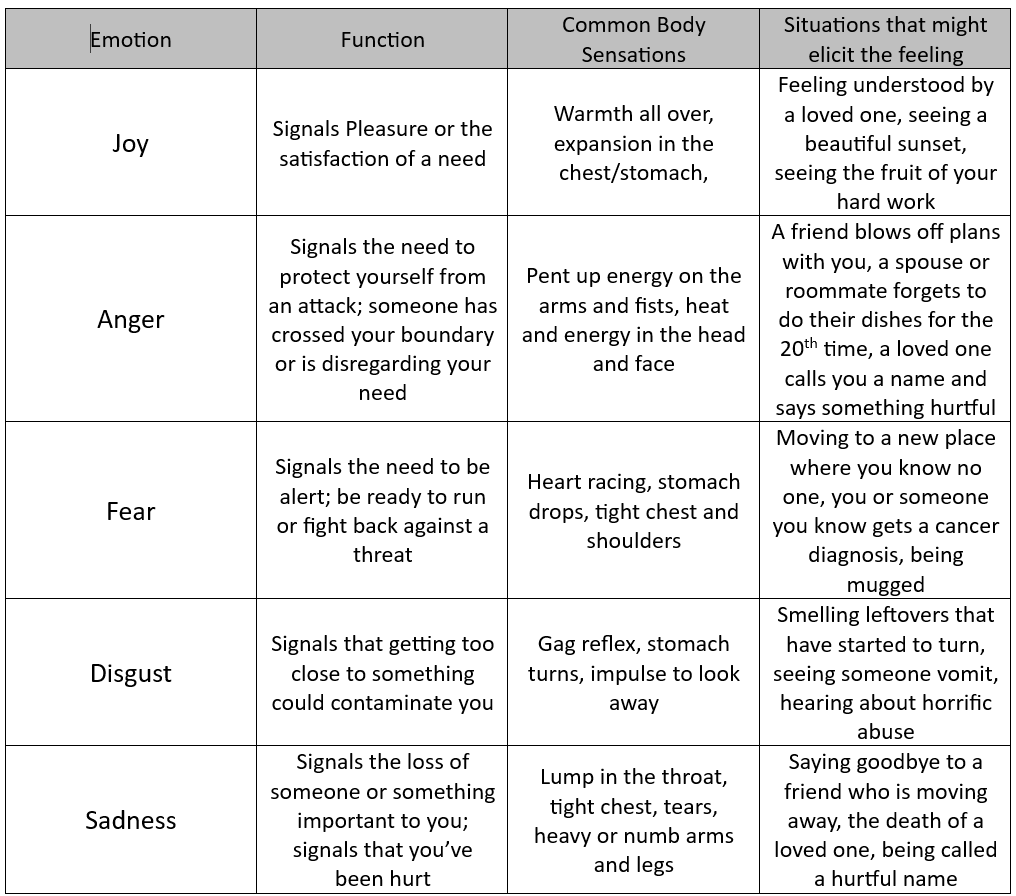
Learning to Speak the Language of Emotions
Raise your hand if you were taught that there are positive and negative emotions. If we were in a sold-out auditorium right now, I bet I’d be looking at a sea of hands. While this is a common (and not totally inaccurate) way of describing emotions, there is a common pitfall with these somewhat misleading terms. It’s true that some emotions like sadness, fear, or anger signal that something negative is happening while other emotions like joy, peace, or relief signal a positive experience. But the problem is that when most people think “positive” and “negative” emotions they really hear that there are ok and not ok emotions. Most often, the bucket of “ok” emotions is small and consists largely of joy and pleasure. That relegates most of the emotions like anger, sadness, and fear to the “not ok” bucket, as in, “not ok to feel”. When we start to attach moral weight to emotions like this, we stifle a perfectly natural, healthy, and necessary process of expressing our emotions. This can lead to anxiety, depression and all the “nesses”: helplessness, powerlessness, and hopelessness. Leaving those mental health struggles behind is possible, but it starts with the very hard work of changing your relationship with your emotions. The first step is understanding that emotions in and of themselves are neutral. There isn’t a hierarchy of emotions. None are more or less ok than any other. They are simply a way of communicating. Our emotions are a set of signals that give us an idea of how the outside world is impacting our inside world. Step two toward a healthier and happier life is learning the language of emotion. Imagine our emotions are like a stop light. For a stoplight to be an effective way of directing traffic and maintaining safety on the road, everyone driving has to understand what red, yellow, and green lights mean. If I was an alien from a nearby planet driving a car on earth for the first time and I didn’t understand that the bright red bulb above the intersection meant stop, I could get seriously hurt or killed by cross traffic. The same is true for our emotions. If I don’t understand what my anger, fear, or sadness are telling me, it can have painful and devastating consequences for my mental health.
To that end, let me acquaint you with the 5 basic categories or families of emotion along with their functions. Each family can be further divided into more nuanced emotions, but for now, the basics will suffice.
Joy
Joy lets us know that we are feeling pleasure. We feel it when our needs, longings, and desires are being satisfied. It can feel like a warmth slowly spreading through our entire bodies or a swelling of our chest. It can feel like an invisible string is connecting us to the people and beauty around us. Joy lets us know that we like what is happening and that we want to keep experiencing it. It might pop up when we feel understood by a loved one, while watching a beautiful sunset, or when seeing the fruit of your hard work.
Anger
Anger is an activating emotion. It needs to be because it signals to us that we are under attack. We need to protect ourselves, our boundaries, our loved ones or whatever it is we care about that is under attack. If someone steps on our toe, the pain also sends a surge of anger through our body. We say “Ow!” and push the person off our foot. Anger is what moves us to action to make sure that people don’t keep stepping on our toes, or worse, walking all over us. For some people, anger is mostly experienced on behalf of others. They feel angry when they see someone they love getting hurt or taken advantage of. Often, the way that anger is experienced in the body is pent up energy in the arms, fists, head or face.
Sadness
Sadness tells us that we’ve experienced a loss or that we’ve been hurt. It slows us down to acknowledge and come to terms with that loss. For some it feels like a lump in the throat, for others it’s a tightness in the chest, and for still others it’s a heaviness in the arms and legs. You might feel it while saying goodbye to a friend who is moving away. It might hang like a cloud
after the death of a loved one. Or you might feel its sting after being called a hurtful name. Sadness makes sure we feel the impact of the hurt or loss without glossing over it.
Fear
Fear is also an activating emotion, but it activates us to a level of alertness. Where anger moves us to action, fear moves us to be ready to act at a moment’s notice. Fear tells us to be ready to run or fight back against a threat. It can show up in your body as a racing heart, a pit in your stomach, or a tightness in your chest and shoulders. You might feel fear when leaving everyone you know to move across country and doubt the soundness of your decision. You might feel fear and want to deny it when you or someone you know gets a cancer diagnosis. You might feel fear while being mugged and have the adrenaline you need to run to safety. Fear helps you know to be cautious and avoid unnecessary danger.
Disgust
Although the first thing that might come to mind might be the mean girl in high school who used disgust as a social weapon to belittle you in public, from a survival standpoint, disgust exists to keep us from getting too close to something that could contaminate us. The forgotten sandwich at the back of the fridge that started growing mold. The sound of someone next to us vomiting. Hearing an account of a horrific case of abuse. Disgust helps us know when something is bad so that we can get rid of it or stay away.
Now that you know the ABCs of the language of emotion, your challenge is to practice listening. As you go about your day, notice when you have an emotional reaction to something. Ask yourself, what am I feeling? What is happening that triggered this emotion? Where is it showing up in my body? What is this emotion trying to tell me about what I need or what I’m experiencing? Feel free to use the summary table below for a quick reference to the 5 basic emotions. Remember, a major component of a healthy and happy life is understanding and appropriately responding to your emotions. The more you practice, the less your emotions control you, and the more energy you have to live the life you want.

